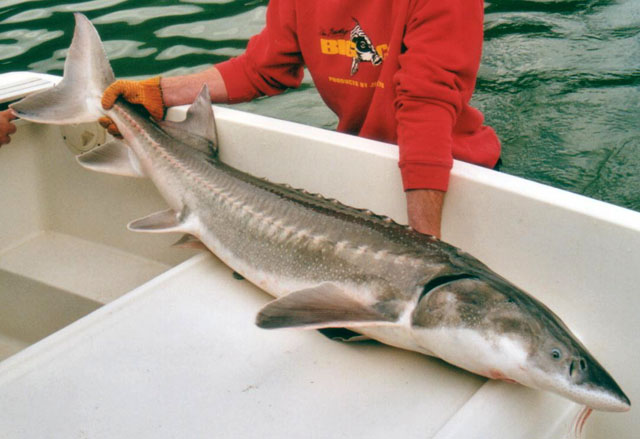| Acipenseridae (Sturgeons), subfamily: Acipenserinae |
| 610 cm TL (male/unsexed); max.weight: 816 kg; max. reported age: 104 years |
|
demersal; freshwater; brackish; marine; depth range 1 - 122 m, anadromous |
| Eastern Pacific: Alaska Bay to Monterey, California, USA. Landlocked in Columbia River drainage, Montana, and perhaps Lake Shasta in California, USA. Translocated to lower Colorado River, Arizona in USA. Reported from northern Baja California, Mexico (Ref. 2850, 27436). |
|
Dorsal spines (total): 0-0; Dorsal soft rays (total): 44-48; Anal soft rays: 28-31. Distinguished by the 2 rows of 4 to 8 bony plates on a midventral line between the anus and anal fin, and about 45 rays in the dorsal fin (Ref. 27547). Gray or brownish above, paler below; fins gray (Ref. 27547). Barbels situated closer to snout tip than to mouth; no obvious scutes behind dorsal and anal fins (Ref. 86798). |
| Spends most of its time in the sea, usually close to shore (Ref. 27547). Enters estuaries of large rivers and moves far inland to spawn (Ref. 5723). Individuals larger than 48.3 cm feed mainly on fishes; smaller ones feed mainly on chironomids, but also takes small crustaceans, other insects and mollusks (Ref. 1998). Feeding ceases just before spawning (Ref. 1998). Excellent food fish that is sold fresh, smoked or frozen (Ref. 9988). Eggs marketed as caviar (Ref. 1998). In the past, the airbladder was made into isinglass (Ref. 27547). |
|
Vulnerable (VU); Date assessed: 15 September 2020 (A2bc) Ref. (130435)
|
| harmless |
Source and more info: www.fishbase.org. For personal, classroom, and other internal use only. Not for publication.

